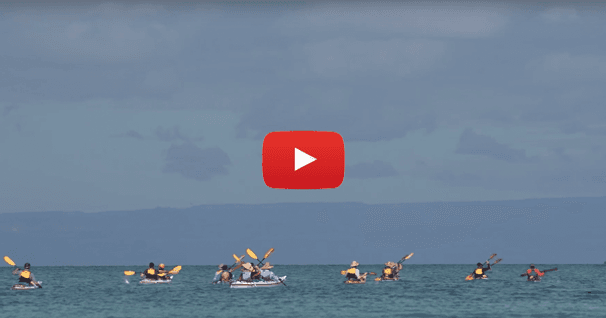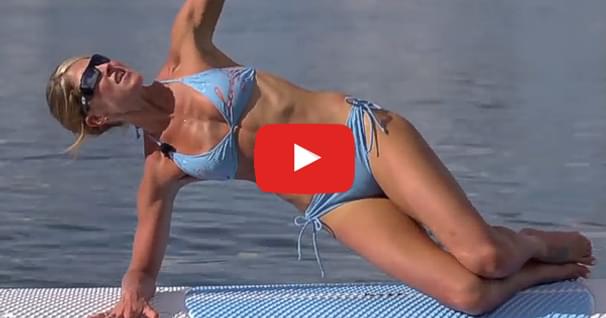Mobility Drills for Paddlers
Here are a few different warm up exercises, mobility drills, that are going to help you loosen up those muscles that you're going to use during paddling.
We're going to go through a series of mobility drills here. We're going to start at the top of the body, moving down to the bottom of the body. You're going to perform each of these for about 30 seconds in total. We're going to start right here at the top at the head; we're going to do a head turn. Real simple; starting looking forward. I'm just going to turn the head off to one side and return. Nice and slow, and controlled; just turning the head, nothing else. No shoulders, don't want the core to move; just the head turn from one side to the other.
Our second one is going to be an arm circle. We're going to perform that arm circle, again, keeping the body nice and stable. No movements through the rest of the body. I'm just going to start warming up those muscles in the shoulders, and warming up the arms a little bit here; getting the rotator cuffs moving. You can go 30 seconds forward and 30 seconds back on each side. I'm just doing one side here. You want to do this through a pain-free and pop-free range of motion, as well. If you start to hear weird pops and cracks, or if it hurts anywhere... so for example if you were right here and it hurt as you're going around that, just go ahead and stop, go to the opposite direction. 30 seconds on each side, 30 seconds each direction.
Our third one's a high pull. For a high pull, we're going to start with the hands facing forward. What I want you to do here is just pull back. You're going to just draw the shoulder blades back, and we're just going to draw the elbows up nice and high, keeping them up at shoulder level. That's a high pull; again, performing that for about 30 seconds.
Our next one is going to be a traffic cop. For a traffic cop, we're starting in this position, getting the elbows up nice and high, getting the arms parallel to the ground, keeping the lower arms... keep the hands hanging down nice and low. From here, we're just rotating up and back. Keeping the shoulders stable, keeping the elbow in this same position, just rotating up and back. Perform that one for about 30 seconds, as well.
Our next one, we're going to get down on the ground here. This is called a quadruped thoracic spine rotation exercise. Need to get that rotation through the thoracic spine, so the middle of your back. For this one, we're going to start down in this ... starting in a 4-point position. I'm going to have you take one hand, bring that hand up, put it right behind the head. You want to keep the hips stable, so you don't want to move the hips at all. All we're looking to do here is just rotate up and back. You just want to rotate that shoulder up nice and high. As little movement as possible through the lumbar spine. This region here, you don't want that to move. You don't want the hips to move. All you're looking for is just a little bit of rotation in the middle of the back. You're going to perform that for 30 seconds on one side, 30 seconds on the opposite side.
Our next one, again down here on the ground from the same position, this one's called the bird dog. We're going to, again, working on the muscles of the shoulder, get a little bit of a balance challenge in here. We're also going to start working on the glutes a little bit. For the bird dog, you're going to start in this 4-point position. We're going to raise the opposite arm and the opposite leg. For the opposite arm and the opposite leg, straight up, nice point, and back. Switch sides. Keeping the core stable so you don't want a lot of movement through this region of the body. You're just looking for a nice point, nice straight line, keeping the head in line with the rest of the body, as well. There's very little movement throughout the core.
Our next one's a fire hydrant. Again, down in this same position. Easiest way to describe this in words: Imagine you're a dog at a fire hydrant. Here we are, 4-point position, working on getting a little bit of mobility of the hips with this one. For this one, all you're doing is bringing the leg up to the side and back. Again, little movement to the rest of the body, but just bringing the leg up out to the side and return. You perform that one for about 30 seconds on each side. I know it's a funny one, but it's definitely effective for the muscles of the hip and the glutes.
Our next one is a squat-to-stand. For a squat-to-stand, you're going to come down into this squat position. You're going to grab the toes; you hold onto the toes. I want you to keep the head in line with the rest of the body. We don't want to bring the head up real high, don't want to tuck the chin. You want to keep it in a neutral position, keep it in line with the body. From here, I'm going to stand up and return; starting to wake up those hamstrings. When you're sitting, those hamstrings tighten up; want to loosen those hamstrings up. There's a squat-to-stand.
Then our last one is a Spiderman crawl. For a Spiderman crawl, what we're going to do is I'm going to have you get this wide offset position. We're going to drop both hands on one side of the foot, so we're looking for this stretch through the hip flexor right here and getting this stretch to the hamstrings up here. Then I'm going to have you rotate to this high knee side. I'm going to rotate up, watching my hand, and return. Get up, move forward, drop the hands again, rotate up, watch the hand, and return. I'm going to keep walking forward like that. I'm going to keep making those steps. Take about 10 steps so you have 5 on each side.
Our last one, I'm going to grab a kayak paddle. For this last one, we're going to do a core rotation using the paddle. You can use a broomstick, you can use anything else, but I'm going to use a kayak paddle for this. For this one, I want my shoulders square to the paddle, line straight up. I'm going to rotate at the hips, keeping my shoulders square to the paddle. We're getting some good core rotation in, keeping the lower body stable; no movement at the lower body, just rotating the core.
These are a great series of mobility drills.
I hope you enjoyed them. Use them well.
John Chase is an ACA certified kayak instructor and a NASM Certified Personal Trainer. John has taught hundreds of personal training clients to use their bodies more efficiently and lead healthier, more productive lives. As a paddling instructor, John has been commended for leading safe, fun, and effective programs.
Related Articles
Engaging your core muscles while stand up paddling allows you to paddle more efficiently for longer…
Whenever you're paddling, there's safety in numbers and so it's generally not a good idea to paddle…
Ready to work that core like never before? This is Jodelle Fitzwater with Bic SUP and this segment is…
This exercise routine specifically targets the arms, and can be completed as part of a full body routine…



